Farm Technology: Opening up Unimagined Possibilities for Women
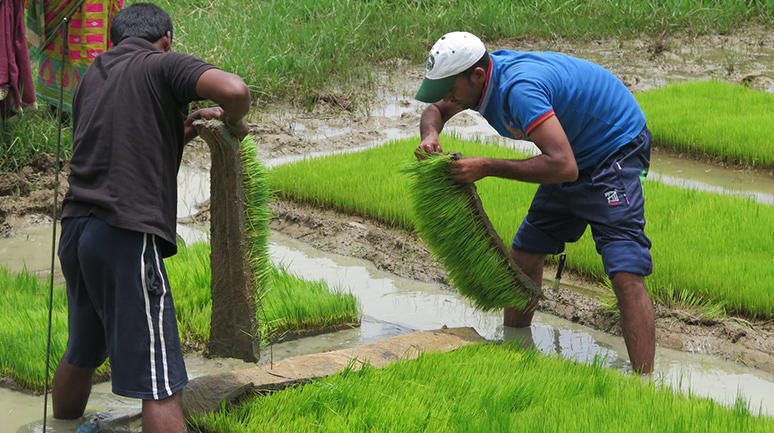
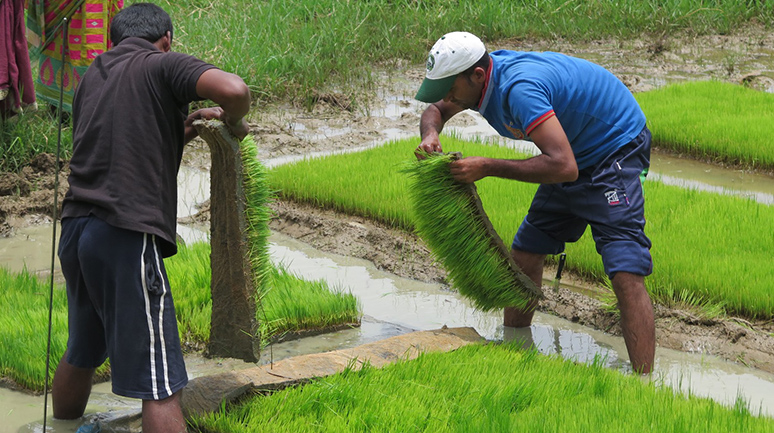
‘A woman worker uses her fingertips on an average 522 times, her fingernails 144 times and her palms 55 times for every single kilogramme of grain that she produces, according to a survey by India’s Ministry of Agriculture.1 ’
W omen do many of the most difficult farm tasks such as seeding, transplanting, weeding, fertilizer application, manuring, plant protection, thinning, harvesting, processing, selling, winnowing, storing, looking after animals and kitchen gardening. All of these tasks are time-consuming and full of drudgery. Manual planting, sowing, weeding and harvesting activities are very hard work.
Although they do more than 70 per cent of the work in the fields and spend their days in farm-based activities, women are not given recognition as farmers. Similarly, although they do all the work in the house, women are not the owners of a single item in the house. They do not even have ownership of themselves. They have no freedom.
Women agricultural labourers are an ‘invisible’ workforce who see farm work as an extension of their roles in the family; others regard them as unpaid assistants to their husbands. Agriculture is the main source of livelihood for most families in PRADAN’s operational area; most are small and marginal farmers with very little landholdings. Agriculture is part of the unorganized sector mainly because there is lack of access to improved agricultural technologies in the area and farming is drudgery.
The term drudgery describes the physical and mental strain, agony and hardship experienced by human beings.
T he term drudgery describes the physical and mental strain, agony and hardship experienced by human beings. It is even more alarming for rural women who, constrained by illiteracy, malnutrition and unemployment, have taken on the heavy burden of agricultural tasks and suffer immensely. There is a strong gender division in agricultural tasks, with women having to spend long hours in painful bent-over postures, leading to miscarriages and high infant mortality.
The strain on women is even more visible during the kharif season when they carry out the transplantation work, remaining bent over or squatting for much of the day. Prolonged squatting sparks off strain and stress that often lead to premature births.
Farmers of Patna block, Keonjhar district, and Kolnara block, Raigada district, in Odisha, spoke of the contribution of women in agriculture during a discussion. We found there are various forms of discrimination in agriculture labour. In Patna block, there is gender discrimination in the labour rate, with the men being paid Rs 350 for ploughing and the women getting Rs 150–200 as farm labourers.
Women, by and large, contribute to two-thirds of the entire labour work. In a small farmer family, where there is minimal nutritional food security, women spend hours and hours of painful labour in their fields and earn an additional Rs 50,000 as cash income. The scenario in Kolnara block is similar. The status of women is rarely considered with respect to their level of income or employment. Their education and health are neglected and their roles within the family, the community and society are considered inferior to that of men.
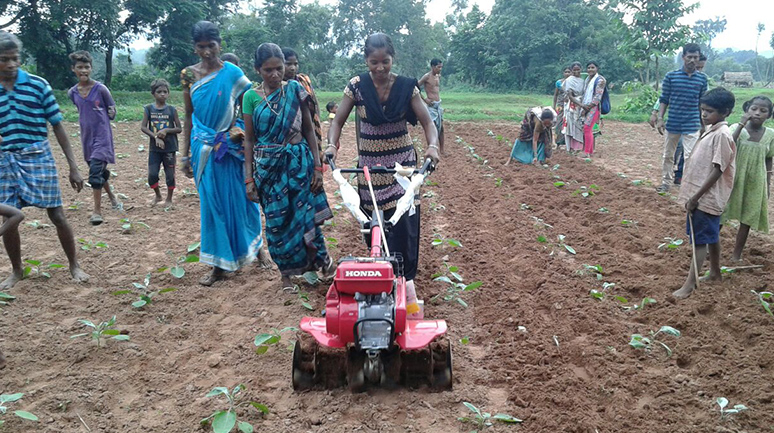
Table 1: Labour Budget of a Sample Farmer Family (of Five Members) with an Average Landholding of 2 Acres
| Expected Yield and Outcomes | Paddy 22 Q, Pulses 40 kg and Cash Rs 50,000 (Food Sufficiency + Rs 50,000 Cash) | ||||||||||
| Major Intervention | Engage Men/ Women | Paddy (1 Acre) | Pulses Blackgram (0.5 Acre) | Creepers with trellis (0.25 Acre) | Solanaceous Crop (0.25 Acre) | Total | |||||
|---|---|---|---|---|---|---|---|---|---|---|---|
| Person day | Cost | Person day | Cost | Person day | Cost | Person day | Cost | Person day | |||
| Ploughing | Men | 11 | 3,300 | 5 | 1,500 | 2.5 | 750 | 3 | 900 | 21.5 | 6,450 |
| Nursery preparation/ Seed sowing | Women | 3 | 600 | 0.25 | 50 | 1.25 | 250 | 0.75 | 175 | 5.25 | 1,075 |
| Land and water management, Pit preparation, Trellis | Both (1:1) | 2 | 400 | 0 | 0 | 19.5 | 4550 | 10 | 2000 | 31.5 | 6,950 |
| Transplanting | Women | 28 | 4200 | 0 | 0 | 0 | 0 | 3 | 600 | 31 | 4,800 |
| Weeding and interculture | Women | 30 | 4500 | 7.25 | 1450 | 10 | 2000 | 11 | 2200 | 58.25 | 10,150 |
| Fertilizer and medicine application | Both (1:1) | 2 | 400 | 0 | 0 | 1.5 | 300 | 1.25 | 250 | 4.75 | 950 |
| Harvesting | Women | 20 | 3000 | 4 | 600 | 7.5 | 1500 | 12 | 2400 | 43.5 | 7,500 |
| Threshing and storing | Both (1:1) | 25 | 5000 | 5 | 1000 | 0 | 0 | 0 | 0 | 30 | 6,000 |
| Marketing | Mostly Men (2:1) | 0 | 0 | 0 | 0 | 12.25 | 2450 | 20 | 4000 | 32.25 | 6,450 |
| Total | 123 | 21400 | 22 | 4600 | 54.5 | 11800 | 61.5 | 12600 | 261 | 50,400 | |
| Note: All costs have been calculated as per locally available labour rate in Patna block | Women’s Contribution (%) | 71% | 66% | ||||||||
The drudgery of women’s work in agriculture impacts their education, food security, health and productivity. Women are the backbone of the agricultural work force; however, nationwide, their hard work has been unpaid and unrecognized just like their other productive and reproductive contributions to the family.
P RADAN’s long-term vision is to bring about socio-economic transformation in women’s lives. An inherent difficulty in conducting a meeting with women in the kharif season, however, is that a woman of a small farmer family spends her entire day in the field and is busy throughout the kharif season to produce food that will take care of her family.
While promoting improved practices in agriculture, we observed that many times farmers were unable to complete their weeding and other activities on time. Because the weeding process is an intense, painful and time-consuming activity and is invariably performed by women in almost all crops in the kharif season, they spend many extra hours at work. The tools that they use for weeding are outdated and very old. The division of work between the men and women is visibly unequal and the strain shows on the women. More than 80 per cent of all Indian women workers are cultivators or farm labourers and most of them do not own a single piece of land. Women are barred from ploughing but they almost exclusively perform all other operations such as transplanting, weeding, harvesting and threshing, and most of the post-harvest work.
Culturally, all machinery work is regarded as the domain of male workers. Men do the ploughing and the marketing and, thereby, control the land and the produce. It is a profound case of socio-capitalism, whereby the women from small-holder farming families are available for work as unpaid farm labour. The drudgery of women’s work in agriculture impacts their education, food security, health and productivity. Women are the backbone of the agricultural work force; however, nationwide, their hard work has been unpaid and unrecognized just like their other productive and reproductive contributions to the family. The present agriculture situation throws up various gender issues, including unequal rights to land and other assets, unequal work load, unequal access to food and health care, unequal wages for work, and unequal control over income.
In Kolnara block, PRADAN has begun realizing the important aspect of gender relations in agriculture. Women are largely occupied with agricultural work from July to November (five months). The crops grown are primarily rain-fed. In the up- lands, paddy is the main crop. Un-irrigated millet and vegetables are grown in a few pockets where perennial streams flow or where large ponds exist. The first peak period of work in agriculture is June-August when the women engage in breaking up sods of earth, sowing and weeding from morning until night. Women bend for whole days to transplant the paddy seedlings in this season, and the process continues for 15 to 25 days.
Sometimes, they transplant paddy while it is raining relentlessly. At such times, they are unable to take care of their up-land crop properly, leading to hampered production. Working in the rain affects their health adversely too. There is no respite for them even after they return to their homes from the fields because they continue with all the house-hold work that awaits them. They do not get adequate rest.
The percentage of single women in Kolnara is around one-third. These women face difficulties every kharif season. They are unable to plough their land because there is a social taboo on women ploughing the land and, either because they have no male members in the family, or because the men-folk have migrated, they have to hire help, usually by paying about Rs 300 for a full day.
Hiring a tractor, to plough half an acre of land, at Rs 900 per hour is also very expensive. Furthermore, the availability of a tractor in the peak season is also uncertain. The women farmers of the Agriculture Production Cluster (APC) have, therefore, taken a decision to purchase a power-tiller, a power-transplanter and a power-weeder for themselves to reduce their drudgery and to save time.
Farm women are a vital part of the Indian economy, constituting more than one-third of the national labour force and a major contributor to the survival of poor families, which depend greatly on the women’s income.
F arm women are a vital part of the Indian economy, constituting more than one-third of the national labour force and a major contributor to the survival of the poor families, which depend greatly on the women’s income. As per the Census of 2011, 263 million people are engaged in agriculture and over half of them are now agricultural labourers, a trend observed for the first time in the past 40 years (Source-www.downtoearth.org. in/news/ farmers-have-decreased- farm-labourers-increased-census- report--40940).
A comparison of the data from Census 2001 and 2011 shows that the number of farmers has decreased by 7.1 per cent and farm labourers have increased by 3.5 per cent, mainly due to the declining size of landholdings, the loss of interest in farming and low profits, where by small and marginal farmers are mostly in the vulnerable stage. Therefore, migration has increased in many farming families.
More than 90 percent of the rural women in India are unskilled. This restricts them to low-paid occupations. They have no control over the land and other production assets, and therefore, they are largely excluded from access to credit, rights and entitlement as farmers. It is very important to empower women through friendly mechanization technology to reduce their drudgery, and lead them to better efficiency, enhanced production and dignified lives. Of course, focussing on mechanization may not create a holistic change; it is an opportunity, however, to create better socio-economic conditions for women farmers.
Mechanization can increase the productivity of crops, reduce the amount of labour required and also provide safety and comfort. It can help reduce the drudgery for women, and give them the scope to engage in other activities such as getting better access, control, ability and assurance in farming. The focus needs to be on gender- friendly farm tools and equipment to sustain the interest of women and ensure their continued involvement in agriculture as farmers. This will entail identifying, demonstrating and making available hardship-reducing technologies in agriculture, animal husbandry and homestead activities, thereby giving women farmers a better quality of life. Some mechanized tools and technologies may motivate men to engage in the work; this will then transfer some of the workload from women to men. Women then will get more leisure time, will access rights and entitlements, will get more economic and social freedom and will have choices available to them.
Using Manual Implements
W omen farmers find manual equipment most effective because these are easier to operate, access and control. Currently, women farmers use a variety of manual implements such as wheel hoe, ridger, paddy cono/mandua weeder, sprayer,iner or marker, and dry land weeder. Gradually, as they begin to use these implements, we observe that they are able to complete many crop practices in time and are increasing the cash crop are in the kharif season. Discussions with the women farmers of the area reveal the importance of different implements (Figure 2).
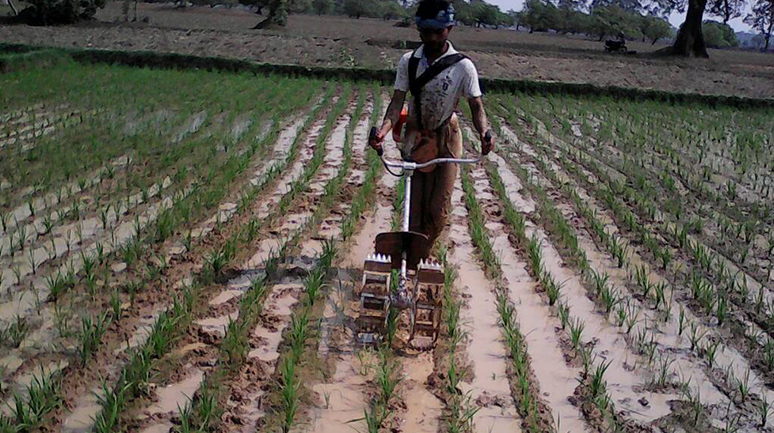
Figure 2: Women-friendly Tools Used in the Area
Table 2: Cost and Efficiency of Manual Implements Used by Women Farmers
| Manual Implements | Paddy Mandua/ Cono Weeder | Wheel Hoe | Sprayer | Dry Land Liner | Weeder | Ridger |
|---|---|---|---|---|---|---|
| Cost (Tentative) | Rs 1,500 (Rs 400 with subsidy) | Rs 1,800 (Rs 450 with subsidy) | Rs 1,700 | Rs 1,700 | Rs 2,300 | Rs 2,100 |
| Crops | Paddy | DSR and vegetables | All | Potato, DSR, pulses, groundnut, etc. | Potato, paddy and other vegetables | Potato, maize |
| Labour Time Efficiency (Mechanized: Manual) | 1:5 | 2:3 | - | - | 1:10 | 1:3 |
| Capacity | 5 labour days/acre | 20 labour days/acre | 2.5 labour days/acre | 1 labour day/ acre | 3 labour days/ acre | 1 labour day/acre |
After mechanizing paddy cultivation, there was a reduction in the cost and time spent on agriculture.
Mechanization in Paddy Production
P addy is the most widely grown and consumed crop in India and across the world. Almost all the small and marginal farmers in these areas of Odisha cultivate paddy. The kharif season is a time for intense labour for women because they work in the fields, with little time to engage in any other work as farmers. Women mostly engage in cultivating paddy in their fields during the kharif season.
Sometimes, they face difficulties and are not able to manage their crops simultaneously in all the fields with same thoroughness. They are not able to complete their agricultural practices in time, and that leads to low production and low income. Often, women are unable to focus on the cash crop neglecting some important interventions such as nursery raising, weeding, ridging and harvesting, due to their intense engagement in the paddy crop.
We tried to understand whether the introduction of some power- operated implements in paddy cultivation would lead to enhanced productivity, profitability and whether that would be beneficial for the small farmers. The Agriculture Production Cluster (APC) provided power-operated machines at a subsidized rate and a major part of the work was done using these machines.
The APC provided services as per the plan of the women farmers. The paddy transplanter was in the greatest demand because this task is critical, owing to the fluctuating and unpredictable rainfall. After mechanizing paddy cultivation, there was a reduction in the cost and time spent on agriculture.
Table 3: Investment and Efficiency of Power-operated Machines for Paddy Production
| No. | Name | Rate(Rs) | Govt. Subsidy | Amount (Rs) | Labour Cost Efficiency | Labour Time Efficiency |
|---|---|---|---|---|---|---|
| 1 | Power tiller | 1,55,500 | 40,000 | 1,15,500 | 1:1 | 1:6 |
| 2 | 4 Row rice transplanter | 2,30,000 | 1,72,500 | 57,500 | 1:2 | 1:55 |
| 3 | Paddy power weeder | 37,000 | 18,500 | 18,500 | 1:5 | 1:40 |
| 4 | Power sprayer | 19,625 | 9,345 | 10,280 | 1:1 | 1:8 |
| 5 | Power reaper | 1,08,000 | 54,000 | 54,000 | 1:3 | 1:60 |
| Total cost for APC | 5,50,125 | 2,94,345 | 2,55,780 | - | - |
Table 4: Economic Comparison of Manual and Mechanized Operations in Growing Paddy
| Cost for 1 Acre Paddy | Mechanized Cost | Manual Cost | Benefits |
|---|---|---|---|
| Main field preparation | 1,200 | 1,200 | Effective ploughing, less time and less dependency |
| Nursery preparation | 800 | 300 | Good quality nursery, including polythene cost |
| Transplanting | 1,500 | 3,300 | Cost-effective, less time and less dependency |
| Weeding (2 times) | 1,000 | 5,250 | Cost-effective, less time and less dependency |
| Medicine spray (2 times) | 500 | 400 | Battery spray with organic medicine |
| Harvesting | 1,000 | 3,000 | Cost-effective, less time and less dependency |
| Total | 6,000 | 13,450 | Labour cost: Less than half |
| Expected Yield | 25 quintal | 18 quintal | Yield: Enhanced by more than 35% |
Turki Didi, Nirvaya Federation
Turki Ataka is a farmer and a single woman in Palipinda village. She stays with her parents and does all the work on her own. Her life is simple just as it is for the other women of a tribal society. She starts her day early in the morning and continues till the evening without any rest. She is a member of a Self Help Group, which is a part of the APC. She represents her village and the Group in many forums such as the APC, the panchayat-level Cluster and the Nirvaya Federation (a block-level Federation of women’s SHGs). When she started to go outside her village for meetings, she said that she became aware about so many things taking place in the world outside.
She told us, “I didn’t see any platform where people talk about women’s drudgery which we face in our everyday work and we also just accept it as our responsibility. This year, we tried something different with our paddy crop. Earlier, my villagers had many doubts and said that the mechanical transplanter machines would not give more production and that the women would not know how to use them. It was quite difficult for me to convince them; when the transplanter was brought to our village for demonstration, they tried to accept it. We (SHG members) were very happy with this intervention because ours was the first village in our block to use the paddy transplanter. In my field, I drove this transplanter on my own.
“Earlier, I used to hire five labourers for transplantation in 50 decimals of land. It would take around one-and-a- half days to complete the work. The labourers took Rs 150 per day and in total I would spend around Rs 1,100 for transplantation in this half acre of land. This year I spent Rs 800 for transplanting in the same piece of land in1.5 hours. Earlier, I got three quintals of paddy from this land; this year, I got four quintals, despite the drought situation that affected around 20 per cent of the crop.”
Table 5: Sample Data on Yield Analysis of Patna Block
| Mechanized Paddy in Same Plots | Year 2015 (Kharif) | Year 2016 (Kharif) | ||||||
| No. | Name of the Farmer | Village | Area (Acre) | Earlier Practice | Variety | Yield (Kg) | Variety | Yield (Kg) |
|---|---|---|---|---|---|---|---|---|
| 1 | Lilabati Naik | Godipokhari | 0.6 | Traditional | Lalat | 400 | DRR42 | 1,200 |
| 2 | Durgabati Mahanta | Bhuluda | 0.3 | Traditional | Lalat | 200 | Mandakini | 800 |
| 3 | Guramani Mahanta | Bhuluda | 0.1 | Traditional | Lalat | 80 | Pratiksha | 300 |
| 4 | Malati Naik | Godipokhari | 0.3 | Traditional | Pratiksha | 400 | DRR 42 | 1,000 |
| 5 | Manjulata Mahanta | Dalanga | 0.12 | DSR | Lalat | 300 | DRR 42 | 440 |
| 6 | Guramani Mahanta | Bhuluda | 0.1 | DSR | Annapurna | 100 | DRR42 | 200 |
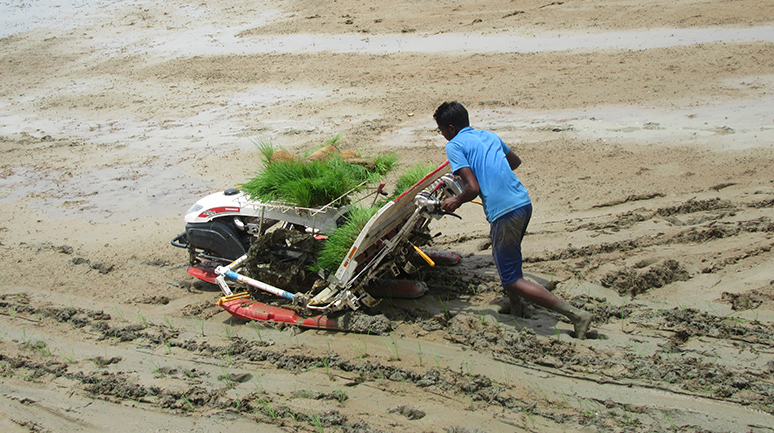
Service Unit At APC
Farm mechanization is a new initiative for the team, and the experience of providing services of power-operated agriculture machine through community institutions is in its experimentation stage. However, with our limited experience, we have visualized that that the APC will be at the panchayat or block-level so that farmers can easily access it. Mechanization being an important part of agriculture intervention of the APC, the PRADAN team has made a business plan for optimal utilization of machines to reach the maximum number of potential farmers and make it affordable. In some areas, the group or local entrepreneurship approach helps us reach the farmers. However, because many of the implements are very new for this area, motivating farmers to use these on a large scale is a challenge for the initial period of one or two years. Therefore, procuring and managing farm implements, are critical factors for APC.
Model 1
We have promoted some SHGs or local entrepreneurs in some APCs, who will deposit at least 15–20 per cent of the amount as advance and gradually the concerned group will refund the full amount to the APC on an installment basis within four to five years. After full repayment, the ownership of the farm implement will be transferred to the entrepreneur and the APC will use this amount as a revolving fund to promote more entrepreneurs in the area. Nevertheless, creating a business plan and assessing the capacity of the entrepreneur on farm technology are necessary components of the promotion.
Model 2
All the farm implements will be under the control of and monitored by APC. APC will hire some local people as drivers to operate the machines. Again, creating a business plan at the APC level, and the implementation and money collection mechanisms and building capacity of the operators are vital components of the promotion.
| Business Model of a Paddy Transplanter | |||
| Broad Assumption | Expenditure Per Hour | ||
|---|---|---|---|
| Depreciation per year (20% of m/c cost) | Rs 46,000 | Depreciation cost | 153 |
| Maximum utilization opportunity in rain-fed paddy area (50 days per year x 6 hr per day) | 300 hr | Fuel and oil cost | 78 |
| Fuel required (@ Rs 65) | 1 ltr/hr | Operator cost | 100 |
| Engine oil (1 pack/20 hr) | Rs 260 | Maintenance cost (Rs 3,000/- per year) | 10 |
| Operator (2 persons @ Rs 300 per day) | Rs 600 | ||
| Farmer’s service charge (per hr)- | Rs 500 | Total expenditure (per hr) | 341 |
| Break-even (total hours) | 152 | Break-even (total area) acre | 76 |
| In both the models, APC finalizes a rate chart for the farmers, based on the service charges. Additionally, APC worked to create demand from women farmers, as per the designed plan and perspective. | |||
Experiences Of Some Farmers And Entrepreneurs
“We’ve learnt new technologies and methods in vegetable cultivation. Now it is easier to cultivate cotton and different vegetables.” Penta Puala, Ambaguda village
“Twenty-five days after the transplanting and before applying fertilizers, the field needs to be weeded. This work is the responsibility of a woman. It is quite difficult to weed the entire land (average 1 acre) within the desired period of time. Continuous engagement is needed to complete the weeding, leading to back pain and body ache; still we continue to work because there is no other option.” Tulasi Himirika, Sarupali village
“These machines are very women- friendly and we now get time for rest. Nowadays, people’s perception of women is changing from considering them merely as labour to that of empowered farmers. We feel very confident when we learn different techniques regarding agriculture (which is our main livelihood), we will and use these machines ourselves.” Sanai Kambrika, Bandhaguda village
There is very little change in the input of women’s manual labour, either because the policies and the investments of mechanization technologies have not catered to the particular needs of women, or because they are inaccessible or unaffordable.
Some Critical Learning and Challenges
- Better technologies have been developed; yet these have not reached the villages and particularly not women farmers. There is very little change in the input of women’s manual labour, either because the policies and the investments of mechanization technologies have not catered to the particular needs of women, or because they are inaccessible or unaffordable. The mechanization process may vary, depending on the need- based perspective and drudgery- reducing technologies.
- The eight-row power-operated transplanter is not suitable for undulating areas, where most small farmers have small and scattered plots.
- APC has purchased power- operated machines through various subsidized schemes of the government and other projects. These implements require regular maintenance and services. Getting regular and quality services from suppliers is a real challenge on the ground in many areas. The selection of suppliers and companies needs to be on the basis of these parameters.
- The maintenance of power- operated machines at the APC level is a new learning for women members. Machines have to be stored in a designated place, need regular maintenance, and protection from damage and misuse.
- The operating process of any machine is a critical factor. The operator of a power-operated machine should have knowledge of the parts, the operating technique and its fuel and oil requirements.
Anjan Swar in Jashipur, Odisha, and Sagarika Satapathy is based in Jaykaypur, Odisha

